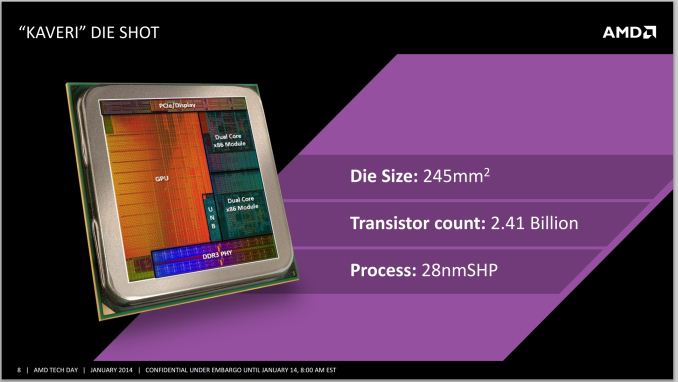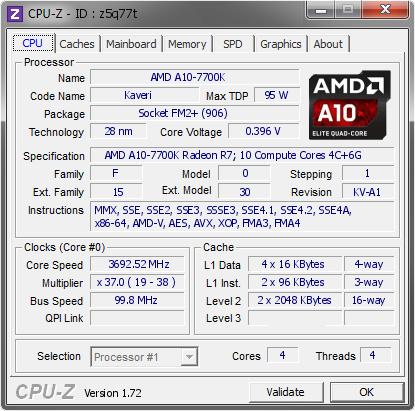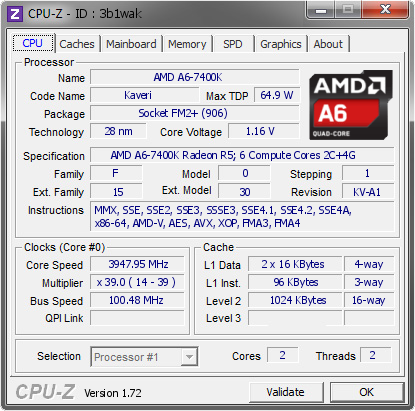The AMD A10-7700K and AMD A6-7400K CPU Mini-Review
by Ian Cutress on May 27, 2015 9:00 AM ESTAMD A10-7700K and AMD A6-7400K Conclusion
I started this mini-review stating that the question of the number of processors that both Intel and AMD produce all seem to differ by 100 MHz and $7, and that I had received questions as to why this is the case. Ultimately a lot of recommendations for computer components start to revolve around ‘Well for $10 more, you could get this’, and at some point you are considering something that costs $50 more. There has to be a point where you stop, especially if an IT department or system builder wants to go through and develop 200+ machines in a month.
Intel and AMD currently have different approaches to this. Intel likes to launch a big part of its stack all at once. Sometimes it will launch individual units outside this, or it will start a new line-up with one or two units then introduce the bulk later. With Haswell for example, on the socketed CPU space, we have 50 different CPUs varying in price, power, frequency, core count, threading and integrated graphics. Imagine the poor reviewer that has to test them all (insert here that I’d love to test them to get all the data, if I had time and could source them)!
AMD’s approach to Kaveri is to dribble rather than gush. Rather than overload the user base (both end-users and commercial) with a large haystack of parts, they launched two or three SKUs on day one, then one or two every 6-12 weeks since. This has some benefits, namely the improvement of the production process over time, the repeated opportunities to market new products and the opportunity to re-educate potential clients through the media. The downside of this strategy is one similar to starting with Swiss cheese and then filling in the holes – if a client wants a SKU with particular characteristics but the company does not have it, then they will go look for something else and take their money with them. It’s a method that acts as a double edged sword.
As AnandTech’s CPU editor, I get to play with a lot more SKUs than most. This means both the big shiny halo products, such as the 8-core goliaths, but also some of the higher volume dual core stuff which is more in line with a budget PC or mass PC build. With AMD’s strategy, as they have fewer processors overall, our coverage can be a little more complete than the others. AMD sampled us both the A10-7700K and the A6-7400K for this purpose, and we hope to work closely with them for future launches and get the best comparison list of their product stack.
Back to the SKUs tested for this mini-review, we can tell that the A10-7700K keeps up with the other A10 parts in our CPU testing, but as it has two fewer compute units in the integrated graphics it can lag behind a little and is more in line with the A8 processors in that regard, essentially making it more of a hybrid part. The A6-7400K fits into that budget CPU line at $64, and the results show this in both our CPU and GPU testing. The single module performs well enough in single threaded environments, but doesn’t have enough legs for the big tasks and can be swamped easily. Despite having two threads, the Bulldozer based design still has single-threaded like behavior in some tests. That being said, the graphics tests are a mixed bag. For titles that can use more threads, I can’t help but feel that it is a little held back, even at 256 SPs. For other titles, it performs on par with other processors almost double its price. Dual Graphics mode unfortunately was not possible with the A6, and it was also noticeable that some games (Shadows of Mordor in particular) took longer to load with only one module.
To say AMD’s APUs are like marmite (you either love them or hate them) is to gloss over a more complex issue. AMD’s design has its plus points and its negative points, a fact that AMD marketing knows when I speak to them. Nevertheless, they have to focus on the plus points, which include gaming at equivalent price points, DX12 support, OpenCL performance and moving forward with HSA. Using the right tool for the right job should now be considered a cliché, but it rings true when it comes to technology and more so than ever when innovative methods are continually being fashioned. Based on AMD’s Financial Analyst Day and their recent exposure into HBM (I highly suggest reading Ryan’s awesome writeup on it), I can safely say that I want to see an APU with HBM in the future. Despite the inevitability that AMD already know that people want one, I told them anyway. We will have to wait and see.














105 Comments
View All Comments
FlushedBubblyJock - Tuesday, June 2, 2015 - link
They're the space age ion cuntress shields, warriors, protecting the helpless and innocent from evil, cockblockers in their own minds, our heroes...zodiacfml - Friday, May 29, 2015 - link
Can't wait for HBM. Once they (AMD) have it on their APUs, Intel will have an equivalent shortly.ES_Revenge - Saturday, May 30, 2015 - link
Ugh, like the 7650K, these CPUs are both pointless nonsense.Like the 7650K v. the 7600, the 7700K uses more power, has a higher price (significantly this time--35%!) and offers very little (if any) performance increase over the 7600. (Just said this a week or two ago in the 7650K review, btw.) Plus the 7700K has no business even having the A10 name as it has the same 384SP as it's A8 siblings.
The A6-7400K should be more like $55, not $64. That's all I'm going to say there.
Fail and fail again :(
The stars here (if there are any in AMD's lineup) are the A8-7600 and the A10-7850K. The 7600 'cause it's 65W TDP and offers nearly identical performance to the 7650K which is 17% more and this new "A10" 7700K which is 35% more. Less power, same performance, less price? Hmm, what seems like the better CPU here? The foolishness-that-is the "A10" 7700K or the A8-7600? Not a tough decision.
I mean is this AMD's whole idea here? "Oh hey let's release two CPUs that are clearly worse value and that way we'll boost 7600 sales."??? LOL.
The 7850K offers the most performance and costs just a few bucks more than the 7800 so that's enough reasoning for me to make it the other stand-out.
The rest of these CPUs are all nonsense; and, because AMD is so far behind Intel in the CPU dept. not even the "stars" of AMD make much sense to most buyers. Sad. More sad is releasing CPUs that are simply pointless.
ES_Revenge - Saturday, May 30, 2015 - link
Oh and BTW don't get me started on the X4 860K. Save $4.00 ($4?! Really?) and *don't* get a GPU yet also have a higher possible TDP? WTF? Uh yeah it's "unlocked" but you're not getting much performance unless you're able to have a 1Ghz OC on the thing, but that's just going to cost you in more power/heat. X4 860K, for $84?....Worst. Idea. Ever.HomingTk - Monday, April 11, 2016 - link
thinking of getting a gaming pc (intended for gaming) with a AMD A10 7700k processor. From reaing the chat I don't know what to think about it. Considering there is possibly another option AMD R7 7650K what should I do?